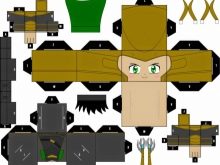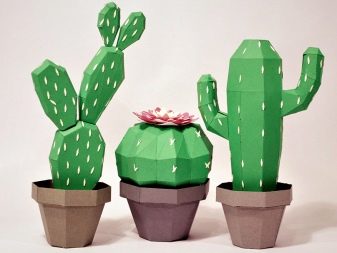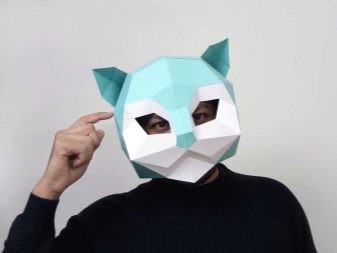All about papercraft

Paper crafts are popular with needlewomen - everyone has probably tried to make appliqués or origami figures. However, there is another type of hand-made paper products that allows you to create geometric models of real things - this is papercraft. In this article we will tell you what kind of art it is, how it appeared and what forms can be made using this technique.



What it is?
Papercraft is paper modeling of various objects created by nature or people. Technique involves the creation of three-dimensional creatures (real or mythical), techniques or geometric shapes. For work, the basis is paper or cardboard - the material is divided into parts and connected in a special way to obtain the required shape. Volumetric paper modeling is a popular hobby, useful recreation and learning to work hard.



Papercraft develops constructive and creative thinking - the creator of the figures will learn to perceive the surrounding objects and objects in a new way.
Paper modeling is as popular as origami, but the two are very different. Origami is the creation of shapes by folding and folding rectangles and squares out of paper without the use of glue. The essence of papercraft is to cut patterns out of paper and glue them together, resulting in a slightly angular, but recognizable figure of a creature or object. The models look very unusual and original, so the technique is very difficult to confuse with anything else.



In most cases, novice needlewomen create models from printed patterns or buying ready-made sets of parts for assembly. Gradually, people get acquainted with the basic principles of technology, proven techniques and common solutions for creating figures. Practice on the basis of ready-made parts helps to gradually create more and more complex models; over time, needlewomen can even learn to come up with and implement their own ideas using papercraft technique.


Each ready-made kit for paper modeling contains instructions in the form of a drawing that you need to learn to read. The creative process of creating objects develops perseverance, attention to detail and the desire to achieve success. The technique provides for a change in the type of activity - manual assembly of patterns alternates with reading and comprehending the drawing. The lack of uniformity prevents a loss of interest in needlework, which is why people usually do this art for a very long time.

History of origin
Many historians are of the opinion that the art of paper modeling originated in China in the 2nd century BC. NS. The Chinese were progressive people - they used papercraft for creativity and room decoration. The direction in art grew and developed, therefore, over time, it turned into a separate craft, widespread throughout eastern Asia. Modeling also migrated to Japan, where the technique has found many different uses.
On the territory of the European continent, paper modeling appeared in the 15th century A.D. NS. The first in Europe, the direction of art began to massively distribute the French - they set up the serial production of printed sets for papercraft. In the beginning, the technique was presented for a long time as a hobby for children - simple objects such as numbers, geometric shapes or an alphabet were created from patterns.


Adults took over the hobby after a while, because a huge potential was hidden behind the simple method of creating figures. The collection of models inspired the poor artists of the time to make more budgetary portraits - an alternative to expensive paints was cut and glued pieces of paper that form a certain volume.


This style of fine art can be found at the present time - it has retained all the features of technology invented by ancient masters.
At the beginning of the 20th century, paper figures finally became popular among the adult population - people began to make original products, regardless of gender and age. The prevalence of hobby led to the active growth of the industry - a huge number of models and forms of various levels of complexity appeared. Realistic models of houses, equipment, flowers and animals, as well as diagrams with a huge number of small details, such as models of real planes, ships and tanks, went on sale.






The paper modeling technique became popular among architects, designers, and engineers who used it to visualize their designs. Among famous people, the direction was actively used in their work by Soviet academicians: aircraft designer Alexander Sergeevich Yakovlev and designer of rocket and space systems Sergei Pavlovich Korolev. This technique is also widely used in the automotive and aviation industries - first, small models are created, and then, on their basis, a full-size technique.


Views
The first criterion by which paper figures are divided into types is the level of complexity of the design. On sale there are light sets with a small number of patterns that are intended for children and beginners. Kits of medium complexity are suitable for those who have already done this kind of work and are able to carefully and carefully fold parts.There are also varieties of the highest difficulty level - they contain a huge number of small parts and are intended for needlewomen who are seriously interested in papercraft. Complex structures are covered with paint and varnish, so it becomes difficult to distinguish them from plastic products.
Paper modeling is still the most popular in Asia and Japan, which is why it was there that they came up with special areas of art: CubeeCraft, ChibiCraft and 3D-PaperModel. We suggest that you familiarize yourself with each type of structure in more detail.
Cubeecraft
The CubeeCraft technique is based on geometric shapes: a square and a rectangle. Following the technique, needlewomen make models from cubes and parallelepipeds. There are two ways to "breathe life" into such creations: beginners create figures from parts on which body parts or parts of mechanisms are originally printed, advanced craftsmen first create a shape and only then apply a drawing.

In the direction of CubeeCraft, creatures are most often depicted, similar in shape to the heroes from the famous game Minecraft. Square heads, bodies, arms and legs are the standard pattern for all figures in this category, only the additional details and the printed pattern differ. This section of paper art contains all the favorite characters of people: cartoon characters, TV series, movies and anime.
The CubeeCraft technique is quite simple, so the masters advise you to start your acquaintance with papercraft with it. This category is suitable for children and beginners, because the kits contain few parts with an easy way to assemble and a huge assortment of favorite characters.



Sometimes, in the form of square crafts, there are not only fictional characters, but also real famous personalities.
ChibiCraft
The ChibiCraft direction appeared in Japan, the basis for modeling products in this technique is anime characters in the chibi style with huge heads and small bodies. Figures in this style can be both simple and quite complex, the main thing is to preserve the special proportions of the character. Most of all, this category of paper art is popular among anime lovers, so there are a huge number of templates for the heroes of such works.
ChibiCraft's product range is mainly composed of characters from popular anime series. However, not only heroes are created using papercraft technique - they also make fantastic and mythical creatures, for example: Pokemon or demons from Japanese culture.


3D-PaperModel
The 3D-PaperModel technique is distinguished by a large number of details and maximum correspondence of the figure to the original. This is the most difficult way to create paper models, which only advanced papercraft masters can do.
The 3D-PaperModel method is used to create home decorations - figurines of animals, plants and mythical creatures are painted with acrylic paint, and they become real sculptures, fitting into any interior. Engineers and designers fully use the 3D-PaperModel technique to create large projects in miniature - this allows you to think over individual elements in advance and prevent difficulties in the manufacture of products in real size.



The method is also used by lovers of steampunk, chivalry and role-playing games in computer games - the 3D-PaperModel technique allows them to create a layout of future elements of an authentic wardrobe.
What can be made from paper?
Papercraft opens up a huge space for craftsmen creativity - you can create simple figurines with children or complex interior models. We propose to consider a list of interesting ideas for paper modeling.
- Square characters. The easiest way to have fun and at the same time useful time with your child is to create a craft with your own hands. Papercraft in the style of CubeeCraft is great for these purposes, in addition, cardboard figures of your favorite characters will become real hand-made toys for children.The technique develops diligence, perseverance in children, improves fine motor skills and attentiveness.


- Complex animal models. Animals have always occupied a special place in the life of people - representatives of the fauna inspire the latter to create airplanes and submarines, as well as to make various crafts. The most popular animals for modeling are the following: owl, dog, deer, fox, cat, panda and crow. Underwater mammals also did not stand aside - the blue whale is used as a prototype for paper figures. They also often create models of mythical creatures such as a unicorn, dragon, pegasus or harpy.




- Products for girls. The fair sex prefer natural crafts, therefore, flowers are most often made using the papercraft technique. It can also be a beautiful heart or a jewelry box in the form of a paper model. Nevertheless, such figurines can also be made by guys, intending to make a gift to women on March 8 or any other holiday.


- Products for guys. Men prefer the following model options: complex mechanisms, engineering structures, technology. These can be detailed vehicles such as tanks, ships, cars, and planes. Often there is a papercraft rocket - engineers use models as the basis of the project. Sometimes people create three-dimensional models from paper, repeating the shapes of houses or entire blocks of high-rise buildings.


A handmade cardboard figure is a great gift for a guy on February 23rd.
- Masks. Paper modeling allows you to create any object, but masks have become especially popular. More often than not, people create masks of various animals that can be worn. It is not difficult to assemble such a product, and the result is very colorful, especially if you cover the mask with acrylic paints to match the color of the animal. If you plan to wear such a piece of clothing, glue it from thick paper or cardboard, and then reinforce it with epoxy.


What will it take to work?
In addition to basic materials such as paper or cardboard, papercraft will also need an additional set of tools and materials. We propose to consider a list of items necessary for creativity.
- Ruler. A thin metal ruler is best for creating neat folds along the lines you marked.
- Scissors. Special clerical scissors for paper or cardboard are suitable, with which you can cut exactly along the marked contour.
- Tweezers. Small parts are difficult to assemble by hand, so you need to stock up on a set of tweezers of different shapes and thicknesses.
- Stationery knife. It will be convenient to cut patterns along a curly line with a sharp blade.
- Glue. Any paper glue or double-sided tape will work, but this is not always necessary - the kit usually includes a special glue for paper models.
- Tool for applying glue. This can be a wooden sushi stick or an ice cream stick, or you can use an awl or an old, damaged screwdriver.
- Pencil. Additional lines are drawn with a simple pencil, you can also use a pen, but it will be difficult to erase it if you need to correct the drawing.

This is a basic list of things needed for paper modeling, but it can be supplemented with additional items. For more complex shapes, craftsmen may need acrylic paints, brushes, varnish and small finishing accessories.

In the kits, the paper for creativity has already been selected, so you do not have to think about it. If you plan to create figures from self-printed templates or your own drawings, you must choose the right base material. It is better to refuse to use thin newsprint and photocopy sheets, otherwise the figures will turn out to be too fragile.Choose parchment paper or thin cardboard - such materials will not tear and at the same time will easily take the desired shape.

Masters also recommend choosing paper with the same color on both sides.
Simple schemes for beginners
Kits of paper modeling for children and beginners contain light sweeps made of thick paper or cardboard, which must be correctly folded and glued by numbers. Each kit includes detailed instructions and a diagram to help you assemble the figurine. We propose to consider a few simple models for beginners in the art of papercraft.
- Lizard. The reptile assembly diagram is very simple, because it consists of only one part. To assemble the figurine, it is necessary to correctly bend and glue the parts of the body - so that the tail, legs and teeth on the back are formed.

- Spongebob. A funny sweep with the popular hero of the children's cartoon of the same name. The lines and dotted lines in the drawing indicate the places of bends, and there are also special slots on the lower part of the head for attaching to the body. SpongeBob's arms are attached between the head and body using a long bar.

- Ladybug. A non-standard scheme, the volume of which is achieved with the help of folds on the insect's shell. The template consists of two parts: an abdomen with a head and a back. First, you need to form a shell, then glue the legs of the abdomen and back, connecting the two parts together. Next, make a fold, marked with a dotted line, and glue the ladybug's face to the back.

- Mario. Every person probably knows this character, because he is the hero of the popular video game of the same name and the mascot of the creator company. The figurine is a standard template and is assembled in the same way as SpongeBob.

- Hello Kitty. The popular Hello Kitty toy for girls is 5-piece glued and is more complex than the other patterns on this list. This is a striking representative of the CubeeCraft style - the finished craft consists entirely of cubes and parallelepipeds.

- Squirrel with a nut. A product made using papercraft technique of medium complexity. Making a model of a squirrel requires certain skills, perseverance and accuracy from needlewomen, so it is better to do it for those who have already done modeling before.

However, the craft is still simple compared to realistic 3D paper models.
How to strengthen a figurine?
For most models, additional reinforcement is not required, for example, if it is an interior sculpture or wall decoration. The density of parchment or cardboard is enough for such man-made products to maintain their shape.
Accessories and wardrobe items, such as masks and imitation armor, need additional reinforcement. These things will be constantly used and exposed to external factors, therefore, to maintain their shape, they must be treated with epoxy resin. This material is effective and easy to use - epoxy is great for making paper models stronger and more resistant to damage.

To strengthen products using the papercraft technique, follow the step-by-step instructions.
- First, prepare the adhesive mixture in the following sequence: thoroughly mix the hardener with the resin, then add alcohol to the solution until you get a liquid and viscous consistency.
- Apply the first layer of hardener to the outside of the craft, then cover the paper with a bandage or thin glass wool.
- Reapply a layer of epoxy over the material, taking care not to damage the sealant. After this step, wait until the resin is completely dry.
- Before the resin is completely dry, it will drip onto the floor. To prevent contamination at home and at the same time to protect the surface of the product from deformation, you need to take additional measures. Hang a piece of wardrobe on a mannequin or blank and set the structure on a bed of newspapers.In the summertime, you can take the item outside and place it in the shade.
- If bumps, smudges and waves form on the surface of the craft, smooth them out with a hairdryer before they dry.
- Once dry, sand the surface with sandpaper and gently apply the epoxy again.


After the last layer of the hardening mixture has dried, all you have to do is apply paints and varnish the item of clothing.








